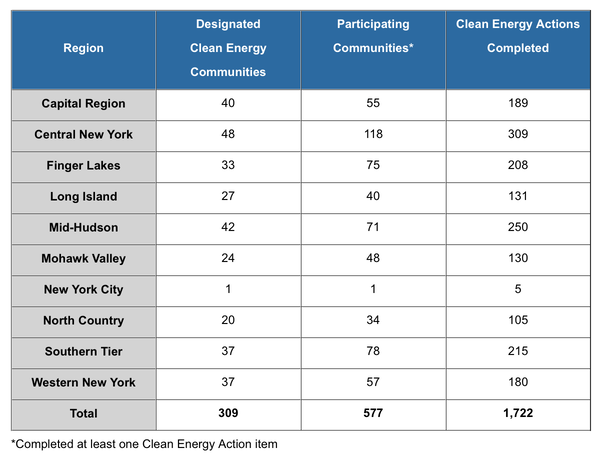- By NYSERDA
- News
 Print
Print 
The New York State Energy Research and Development Authority (NYSERDA) announced Tuesday that more than 300 communities across the state have earned the Clean Energy Community designation, completing more than 1,700 total high-impact clean energy actions. The designation recognizes community leadership in reducing energy use, cutting costs, and driving clean energy, all of which are advancing Governor Andrew M. Cuomo’s Green New Deal – the nation-leading clean energy and jobs agenda putting New York on the path to a carbon-free power grid by 2040 and a carbon-neutral economy.
Alicia Barton, President and CEO, NYSERDA said, “Under his unwavering leadership, Governor Cuomo is empowering more local communities to join in the State’s efforts to reduce statewide emissions and combat climate change through programs like this. Congratulations to all the Clean Energy Communities across New York for taking on a leadership role with these significant actions to reduce their energy use and costs while helping to support New York’s nation-leading clean energy goals.”
Announced by Governor Cuomo in August 2016, the $16 million Clean Energy Communities initiative, administered by the New York Energy Research and Development Authority (NYSERDA), supports local governments across the state by providing grants to eligible municipalities to implement energy efficiency, renewable energy, and sustainable development projects in their communities.
Overall, more than 1,700 high-impact clean energy actions were completed by communities representing more than 91 percent of the state’s population in 61 counties and all 10 Economic Development Council regions. Some of the largest communities across New York State have been designated Clean Energy Communities, including the City of New York, Erie County and City of Rochester. View a map showing Clean Energy Communities, actions completed, and communities engaged in the Clean Energy Communities Initiative.
More than 570 communities are participating in the Clean Energy Communities initiative and have completed at least one high-impact action. The following table highlights participation in each region of the state:

New York State Department of Environmental Conservation (DEC) Commissioner Basil Seggos said, “New York State’s Climate Smart Communities program (CSC) works in partnership with NYSERDA’s CEC program to help local governments take action to reduce greenhouse gas emissions and adapt to our changing climate. At a time when the federal government is rolling back critical environmental programs and protections, we congratulate NYSERDA on reaching this milestone and working with communities to combat climate change. In New York State, 45 percent of the population lives in a registered CSC and 21 percent of residents are now living in certified CSCs. Including New York City’s program, more than 60 percent of the state’s residents live in communities taking action to help protect the environment for future generations.”
Under the Clean Energy Communities program, cities, counties, towns and villages that completed at least four of 10 high-impact clean energy actions are designated as Clean Energy Communities and were eligible to apply for funding of up to $250,000 to finance additional clean energy projects. Areas with fewer than 40,000 residents were eligible to apply for up to $100,000 in funding. Grants, which have historically been provided through the Clean Energy Fund and the Regional Greenhouse Gas Initiative, are fully exhausted at this time. NYSERDA expects to release a new update to the Clean Energy Communities Program in the coming months to provide communities new opportunities for grants and recognition while driving the next level of impact.
Key highlights of clean energy actions communities completed across the state include:
- 100 cities, towns and villages across New York have converted approximately 290,000 streetlights to light-emitting diode (LED);
- Over 630 electric vehicles deployed as part of clean municipal fleets;
- Nearly 1,000 electric vehicle charging ports installed;
- 930 code officers and other municipal officials completed energy code enforcement training;
- 342 communities adopted the New York State Unified Solar Permit.
DEC's Climate Smart Communities (CSC) program was launched on Earth Day in 2009, and is an interagency initiative that helps local governments take action to reduce greenhouse gas emissions and adapt to a changing climate. It is jointly sponsored by the following seven New York State agencies: Department of Environmental Conservation; NYSERDA; Department of Public Service; Department of State; Department of Transportation; Department of Health, and the New York Power Authority. The program offers grants, rebates for electric vehicles, and free technical assistance to interested communities.
On April 16, 2020, New York State celebrated the village of West Winfield in
Herkimer County as the 300th municipality in the state to become a registered Climate Smart Community. The village’s resolution states that “the effects of climate change will endanger our infrastructure, economy and livelihoods; harm our farms, orchards, and ecological communities, including native fish and wildlife populations; spread invasive species and exotic diseases; reduce drinking water supplies and recreational opportunities; and pose health threats to our citizens.” Through this pledge, the village plans to “reduce greenhouse gas emissions and adapt to a changing climate,” preparing its community for a more resilient future.
Local governments across New York State have mobilized in response to the current public health crisis to reduce the spread of COVID-19 and protect their residents. NYSERDA remains open for business to support communities and local businesses in assessing and benefitting from clean energy actions and combatting the effects of climate change when they are able to do so. Clean Energy Community Coordinators are available at no charge to help communities develop and prioritize clean energy goals; access easy-to-use resources, such as guidance documents and case studies; and take advantage of available funding and technical assistance opportunities. Local government officials or employees can find contact information for their respective coordinator here for assistance in completing the actions.
v16i22



